
Obsidian Revenant
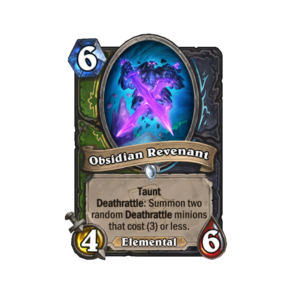
This is a very slow card that can be compared to Savannah Highmane. While it does have taunt, the Revenant doesn’t apply as much pressure on the opponent initially. Its upside comes from its stickiness, since the summoned deathrattle minions are likely to exceed a couple of 2/2 Hyenas in value.
But ultimately, Highmane doesn’t belong in constructed format, and neither does a card that’s slightly better than Highmane. We just can’t think of a deck, in either class, that would be interested. This is too slow for a Cleave Hunter deck, for example.
Score: 1
Mismatched Fossil
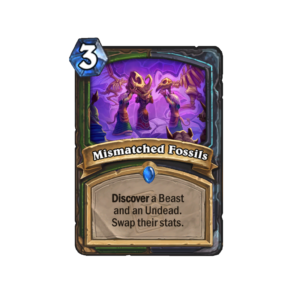
Discovering two minions for 3 mana is quite an awful deal at its baseline. The goal of Mismatched Fossil is to discover two minions of extreme differences in stats and costs, so that one of them becomes a powerful play on turn 4. You’re essentially discovering one playable minion and hoping to cheese the opponent with it. This sounds very unreliable for a big price of skipping turn 3.
What’s worse is the idea of playing this card after turn 3, since the longer the game goes on, the less impactful this kind of “stat cheating” is. Sounds quite horrible.
Score: 1
Quartzite Crusher
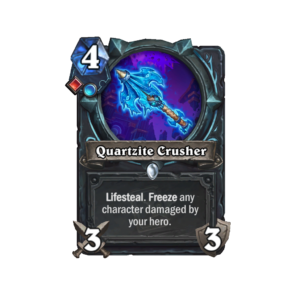
This weapon can be compared to Craftsman’s Hammer, as both are worth 9 effective life over 3 swings. While lifesteal is generally worse than armor gain (because you could overheal, while armor is guaranteed), the bonus of freezing every character hit by the weapon could be very impactful in some matchups. Crusher can completely shut down a late game Ignis weapon, an Odyn Warrior, or turn a Demon Hunter’s game plan into a nightmare. The power of this weapon really comes online when you can hit your opponent in the head rather than kill their minions. Considering that Craftman’s Hammer is an extremely strong weapon, Crusher looks promising.
The card’s biggest problem is its rune restriction, which locks it into Rainbow Death Knight and nothing else. Rainbow DK has shown some promise this week, with new iterations that seem capable of competing, so we’re not writing this card off. Ironically, Crusher isn’t the best fit for these iterations since they’re intensely focused on generating corpses. Still, they are likely to fit Crusher in since it’s a strong standalone card.
Score: 3
Mining Casualties
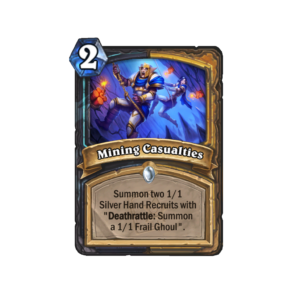
This is a solid early game card for both Death Knight and Paladin. Paladin is sorely lacking proactive turn 2 plays, which Mining Casualties perfectly provides. We particularly like it for a Dude Paladin variant. It fills the curve nicely into a turn 3 Muster/Boogie and helps infuse a turn 4 Buffet Biggun. Remember that Frail Ghouls have charge, which might provide significant damage from Crusader Aura.
For Death Knight, this is an excellent corpse generator and early game threat. Four corpses for 2 mana, while not giving up an inch fighting for board, is very valuable. The deathrattle tokens being undead could be relevant for Nerubian Vizier. For Unholy-Aggro DK, this should be a staple… once living humans decide to play the archetype. For a deck like Rainbow DK, this card should also be a staple, as it accelerates a Corpse Bride/Malignant Horror follow up, as well as Reska.
The best part: dual class cards can’t have rune restrictions!
Score: 4
Prosthetic Hand
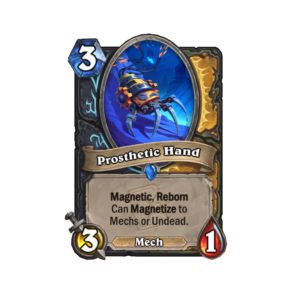
Similar card to Absorbant Parasite. Same stat line, while applying to undead alongside mechs, rather than beasts. Costs 1 more mana, which is significant, but adds Reborn. Remember that the Reborn keyword applies to the minion that gets magnetized! If you magnetize a Distressed Kvaldir, then the Reborn keyword will summon another Kvaldir, not a Prosthetic Hand.
Not that we’re looking to magnetize Kvaldir, but rather than act solely as a purely aggressive card in decks like Mech Paladin or Unholy-Aggro Death Knight, Prosthetic Hand could make for an enticing combo with Reska.
Do we have enough applications for Prosthetic Hand outside of Reska? That’s the biggest question that will determine whether this card is good enough or not.
Score: 2

Fossilized Kaleidosaur

Paladin gets an excavate package. The bonus effects are the same ones that can be acquired by One-Amalgam Band, so we’re looking at a 4 mana 3/4 with two of those, on top of excavating a treasure.
Looking at most combinations of keywords, Kaleidosaur should be a fine play on curve. The biggest upside of the card is that it’s proactive. You don’t need a specific game state to drop it. It’s always ready, which is valuable for a deck that looks to excavate as quickly as possible. If Kobold Miner is good enough as a 2 mana 1/1, then Kaleidosaur should be quite playable. What’s also nice is that it’s a decent minion to play even after you’ve already played Paladin’s Tier 4 treasure, since the keywords scale strongly with extra stats.
Score: 3
The Azerite Dragon
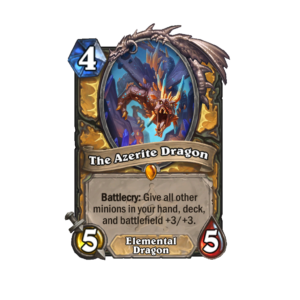
Not a collectable card, but we must talk about Paladin’s Tier 4 treasure. The buff is massive. 3/3 is a lot, while applying to every friendly minion, regardless of where it is. It’s easy to focus on the handbuffing aspect of the Dragon, while forgetting that this card can just kill your opponent if you have minions in play, since it’s a board buff as well. It produces the immediate attack power of Grave Strength at the same cost.
The only bad thing we can say about it is that it’s not the most creative treasure. It’s the first idea we would think of for a Paladin treasure. But when it comes to power, it has a great chance of becoming relevant. It’s not going to be easy to outlast the stat output that this card can produce.
Score: 4
Shroomscavate
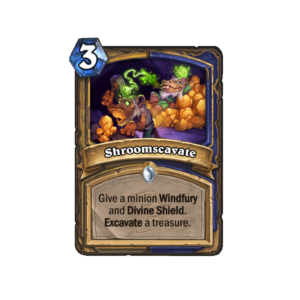
This is a weird excavate card. On one hand, it seems very conditional. You need to have a minion in play, preferably a minion that’s worth buffing. A silver hand recruit or a totem are not great targets for it. Excavate cards are best when they’re proactive and can be played in any game state, so those are negative points for this spell.
On the other hand, this spell seems quite strong in the mid-late game, where it can just kill opponents or devastate their board if a single threat of yours has managed to survive. It also has good synergy with the Azerite Dragon.
We don’t like the fact that the opponent can deny this spell from connecting by overtrading, which can set both Paladin and Shaman behind on their excavate counters, but Paladin’s other excavate card being proactive is helpful here. This spell can be quite dangerous.
Score: 3
Sir Finley, the Intrepid
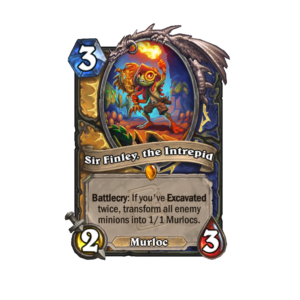
A dual class payoff for the newly excavating duo of Paladin and Shaman, Finley seems kind of nuts. A 3 mana 2/3 that exclusively transforms enemy minions into murlocs makes for a very cracked pseudo-board clear. In fact, Finley is so cheap that even if it just hits a single big threat, it’s very much worth it for the cost.
The only caveat is that it needs activation with two excavate cards, so we can’t play it super early, but we don’t think it’s a slight on the card at all. We don’t want to play Finley very early anyway, and it’s still likely to come online earlier than Badlands Brawler, which has proven itself to be a fantastic excavate payoff.
Finley is so strong that it might encourage Shaman and Paladin to play excavate cards without leveraging their Tier 4 treasures fully. We can see Finley being played in Reno decks, for example. It’s just that good.
Score: 4

Digging Straight Down
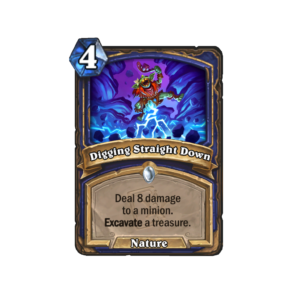
Same mana cost as Paladin’s 4 mana excavate card, but Digging Straight Down is most likely worse. Reactive excavate cards tend to be not great, especially when they require very specific game states to be useful. If your opponent doesn’t have a BIG threat in play, this spell will feel very underwhelming. It’s possible that Shaman will have to play it on small minions just to progress their excavation, which means that it won’t be very efficient. The comparison with Invasive Shadeleaf doesn’t put it in a great light.
However, there is a chance that Shaman will not be racing to find its Tier 4 treasure, choosing to be content with having enough activators for Finley instead, much like the 30-card variant of Control Warrior running Badlands Brawler. In that scenario, a removal card can sit in hand longer and wait for the right moment to be played. For that reason, we like Digging Straight Down in Reno Shaman more than in Excavate Shaman
Score: 2
The Azerite Murloc
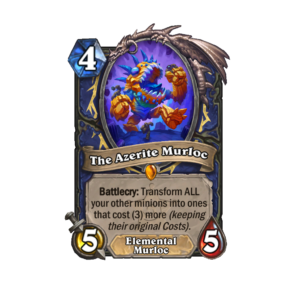
In a way, this treasure resembles The Azerite Dragon, because the core concept for both is pushing more stats and value for the same mana cost. The big difference here is that the Azerite Dragon is far more reliable as a game closer, while not disrupting your deck’s core synergies. The fact that the Azerite Murloc transforms all your minions means that you may have a Deck of Lunacy now, but you got it much later in the game and you don’t have a reliable way of closing out the game. You’re hoping that the effect becomes overwhelming.
If you have a board as a Paladin, The Azerite Dragon can just kill the opponent. With Shaman, you can’t push a lot of damage with the Murloc in hand and a board in play. It gives the opponent another turn to survive. If you haven’t found Finley, then it’s lost once you play the Murloc too, alongside your excavate minions.
The treasure is not outright terrible, but it’s clearly worse than its Paladin counterpart. We still think that Shaman will look to run excavate cards, but it will do it because of Finley, more than this Murloc. The idea of an Evolve Shaman built around excavation doesn’t excite us as much.
Score: 2
Needlerock Totem
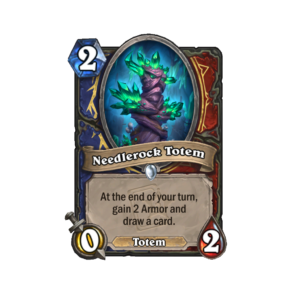
A much stronger version of Mana Tide Totem. Needlerock Totem costs 2 mana with 1 less health (worthwhile tradeoff by itself), while also gaining 2 armor at the end of every turn. Just recently, a very similar card in Gold Panner has ended up constructed worthy. Needlerock Totem is arguably better because of the armor gain. The opponent just cannot ignore it.
Obviously, this card has tribal implications. It goes straight into Totem Shaman, but this archetype has been non-existent for a while. In Warrior, we can see it being played in Menagerie or Blackrock lists, but they’re obviously not a guarantee.
The simplest and most likely use for it is in Reno decks. Both classes have good reasons to play Reno now. Needlerock should make the 30.
Score: 3
Aftershocks
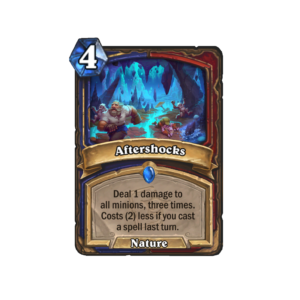
Dealing AOE damage in separate waves is always better than dealing AOE damage in one flow. There are two reasons for this. The first is that separate waves are much better at dealing with deathrattle or reborn minions. The second is that separate waves scale with spell damage or similar effects.
So, at its baseline, Aftershock is already better than plain AOE spells you often see at 4-5 mana that deal 3 damage. But when you add the discount to the equation, which is quite trivial (playing a spell the previous turn is not hard to do), then Aftershock becomes nuts. For 2 mana, we’re wiping every early game board out there, no matter how sticky it is.
But that’s not all. It’s a Nature spell in Shaman too, so this card seems very good in Nature Shaman. In this archetype, the ceiling of Aftershock is quite high.
The card is good enough to see play in every type of defensive deck, and then it might be transformative for an archetype that has been waiting for a board clear.
Score: 3

While Crystal Cluster is great at 5 (with coin), 6 and 10 mana, it’s not very good from 7 to 9. At 7 mana, it only ramps by 2 and gives no taunt. At 8 mana, it only ramps by 1 and gives a single taunt. At 9 mana, it ramps by zero and gives only 2. The problem being that it doesn’t give you the last taunt based on the fact that going from 9 to 10 is useless since you’d get it at the start of next turn anyway.
Clearly a newbie mistake to evaluate cards this way, and this early. I’d recommend to spend some time actually playing the game before commenting next time 😃
This guy’s comment IS based on actual gameplay experience.
9 mana ramps(Wild growth, Overgrowth) has NEVER given you a bonus draw
So it is reasonable to expect no taunts at 7 mana.